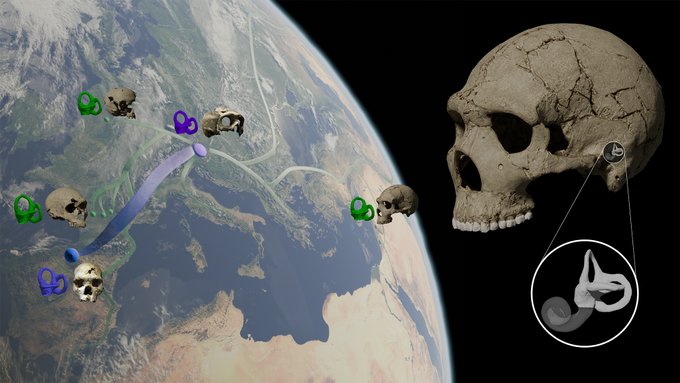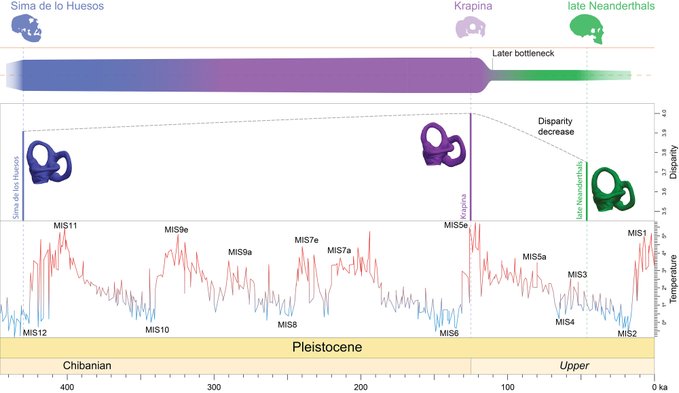A new study by an international team of scholars, including faculty at Binghamton University, suggests that Neanderthals experienced a dramatic loss of genetic variation during the course of their evolution, foreshadowing their eventual extinction.
The study, co-authored by Professor of Anthropology Rolf Quam and graduate student Brian Keeling, measured the morphological diversity in the semicircular canals, structures of the inner ear responsible for our sense of balance, in two exceptional collections of human fossils from the sites of Atapuerca (Spain) and Krapina (Croatia), as well as from various European and Western Asian sites.
"The development of the inner ear structures is known to be under very tight genetic control, since they are fully formed at the time of birth," said Quam. "This makes variation in the semicircular canals an ideal proxy for studying evolutionary relationships between species in the past since any differences between fossil specimens reflect underlying genetic differences. The present study represents a novel approach to estimating genetic diversity within Neandertal populations."

The Atapuerca fossils-referred to as "pre-Neanderthals"-date to about 400,000 years ago and represent the earliest fossils that anthropologists consider clear Neandertal ancestors. The Neanderthals emerged around 250,000 years ago from these populations which inhabited the Eurasian continent between 500,000 and 250,000 years ago. The Croatian site of Krapina represents the most complete collection of early Neanderthals and dates to approximately 130,000 years ago. The researchers calculated the amount of morphological diversity (i.e., disparity) of the semicircular canals of both samples, comparing them with each other and with a sample of "classic" Neanderthals of different ages and geographical origins.
"It is exciting to be included in this research project which relies on some of the latest cutting-edge methodologies in our field," said Keeling. "As a student of human evolution, I am always amazed at research that pushes the boundaries of our knowledge."
Recent research based on ancient DNA samples extracted from fossils revealed the existence of a drastic loss of genetic diversity between early Neanderthals and the later "classic" Neanderthals. Technically known as a "bottleneck", this genetic loss is frequently the consequence of a reduction in the number of individuals of a population. The ancient DNA data indicate that the decline in genetic variation took place approximately 110,000 years ago.

The new study's findings reveal that the morphological diversity of the semicircular canals of classic Neanderthals is clearly lower than that of pre-Neanderthals and early Neanderthals, which aligns with the ancient DNA results.
The study was led by Alessandro Urciuoli (Institut Català de Paleontologia Miquel Crusafont, Universitat Autònoma de Barcelona) and Mercedes Conde-Valverde (director of the Cátedra de Otoacústica Evolutiva de HM Hospitales y la Universidad de Alcalá). Conde-Valverde, co-author of the study, emphasized the importance of the analyzed sample.
"By including fossils from a wide geographical and temporal range, we were able to capture a comprehensive picture of Neanderthal evolution," said Conde-Valverde. "The reduction in diversity observed between the Krapina sample and classic Neanderthals is especially striking and clear, providing strong evidence of a bottleneck event."
On the other hand, the results challenge the previously accepted idea that the origin of the Neanderthal lineage was associated with a significant loss of genetic diversity, prompting the need to propose new explanations for their origin.
"We were surprised to find that the pre-Neanderthals from the Sima de los Huesos exhibited a level of morphological diversity similar to that of the early Neanderthals from Krapina," said Alessandro Urciuoli, lead author of the study. "This challenges the common assumption of a bottleneck event at the origin of the Neanderthal lineage."
The study, "Semicircular canals shed light on bottleneck events in the evolution of the Neanderthal clade," was published in Nature Communications.








